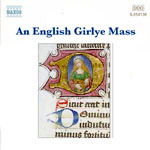Early music always has been a sort of premium, upper-class enterprise, exemplified by really expensive concerts and top-price recordings by groups such as Anonymous 4 (An English Ladymass, The Lily & the Lamb, etc.), the Hilliard Ensemble (Officium, Mnemosyne, etc.), and the Tallis Scholars (works of Victoria, Byrd, Josquin, Palestrina, etc.). Now Naxos, with inimitable understatement, has assured the common masses an easy entry into this rarefied world with this first volume (of a proposed 188-disc series) of music by the Maydstone Maydens, the “world’s first budget equal voice female early music vocal ensemble”. Beginning with its size–only three singers–and its manuscript sources–unwanted fragments of unverifiable origin–this marginally first-rate group furthers its “for the people” image by giving all of its concerts for free in shopping malls and outlet lingerie stores and sells its CDs at even lower than the standard Naxos budget price.
An English Girlye Mass was chosen to begin the series because it exemplifies the firm principles of the group to perform only music that requires virtually no knowledge of style, cannot be compared to anything else, and won’t distract a listener from whatever else he’s doing. The music, coughed up by a large fish while lying on the deck of the British research vessel H.M.S. Richard Starkey in the summer of 1998, naturally exists only in small, slime-encrusted fragments, which were meticulously pieced together into a rather pathetic but still fake-able performing edition by noted piscatomusicologist Ogden Baxter-Harris. Long believed missing, this 12th-century manuscript–known to ancient church scribes as the “Marmite Codex”–was stolen around the year 1345 from the vaults of the monastery at Moulestone (Yorkshire) and somehow fell into the hands of a roving band of mischievous countertenor minstrel/dramatists, known affectionately to medieval English countryside audiences as Pope Gregory’s Girls, who carried their music (and other assorted tools of their “trade”) around in a worsted wool sack.
While on a journey across the Channel to France their ship was lost in a storm and was never seen again. According to Baxter-Harris, the fish must have come upon the wreck, all these centuries later, swallowed what was left of the bag of music, and simply “regurgitated it” upon arriving unceremoniously on the deck of the Starkey. Given the piecemeal state of the manuscript, and its rather odd manner of rediscovery, Baxter-Harris explains with some seriousness (and a certain prideful humor) in the liner notes that “we in the field have assigned the Girlye Mass the subtitle ‘Fish-n-chips Mass’–to distinguish it from the other rumored but never located Girlye Masses, known as the ‘Toad in the Hole’ and ‘Bangers-n-mash'” (manuscripts that were out-of-copy even in their own time–but that’s another story).
The entire performance of the Girlye Mass (Fish-n-chips) lasts less than seven minutes: we hear the beginning of a Kyrie (six seconds), the first three syllables of the Gloria (four seconds), and a complete Agnus Dei. The three voice parts are in exactly the same range and are always overlapping and crashing into each other with no discernible musical purpose. Several modern theorists have suggested that these parts really don’t go together at all but actually belong to a set of dances composed by blind 12th-century monk, Friar Mergatroyd Tuck of Monmouth, a distant relative of the celebrated Tuck of Nottingham. This theory has yet to be proved, but if it is (or even if it isn’t) we can look forward to hearing segments of the Mergatroyd Manuscripts, soon to be recorded by Naxos’ budget medieval instrumental group, The Queene’s Commotion (due for release this fall).
Meanwhile, we’re left to savor the minuscule morsels of music sung here by these miraculous Maydstone Maydens–who perform with admittedly sincere devotion, impeccable intonation, complete oneness of vocal quality (if you think it sounds like only one voice, overdubbed, you may be on to something), and absolutely no clue how to sing Latin. The sound, from the vault of the original Moulestone monastery from which the manuscript was stolen, is predictably dank and musty. The pretentious, self-indulgent liner notes by Baxter-Harris, with several pages of thank-yous to their families and friends added by each of the three Maydens, may make you feel like doing what that fish did when he brought this whole thing up. [4/2/2002]
































